英语强调句型
- 格式:ppt
- 大小:235.00 KB
- 文档页数:22
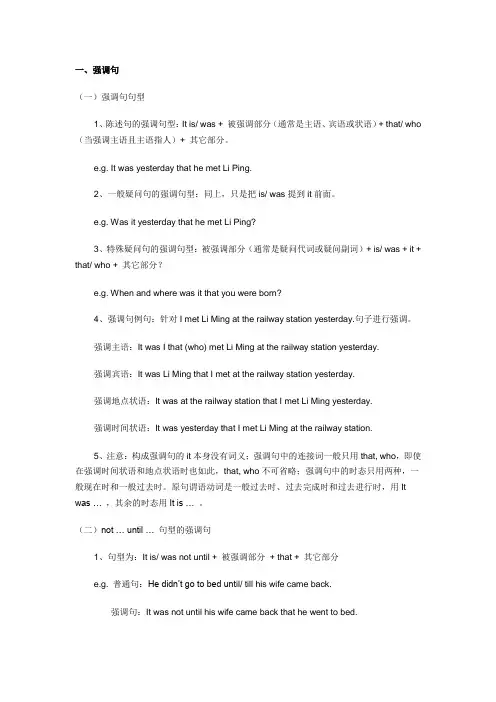
一、强调句(一)强调句句型1、陈述句的强调句型:It is/ was + 被强调部分(通常是主语、宾语或状语)+ that/ who (当强调主语且主语指人)+ 其它部分。
e.g. It was yesterday that he met Li Ping.2、一般疑问句的强调句型:同上,只是把is/ was提到it前面。
e.g. Was it yesterday that he met Li Ping?3、特殊疑问句的强调句型:被强调部分(通常是疑问代词或疑问副词)+ is/ was + it + that/ who + 其它部分?e.g. When and where was it that you were born?4、强调句例句:针对I met Li Ming at the railway station yesterday.句子进行强调。
强调主语:It was I that (who) met Li Ming at the railway station yesterday.强调宾语:It was Li Ming that I met at the railway station yesterday.强调地点状语:It was at the railway station that I met Li Ming yesterday.强调时间状语:It was yesterday that I met Li Ming at the railway station.5、注意:构成强调句的it本身没有词义;强调句中的连接词一般只用that, who,即使在强调时间状语和地点状语时也如此,that, who不可省略;强调句中的时态只用两种,一般现在时和一般过去时。
原句谓语动词是一般过去时、过去完成时和过去进行时,用It was … ,其余的时态用It is … 。
(二)not … until … 句型的强调句1、句型为:It is/ was not until + 被强调部分+ that + 其它部分e.g. 普通句:He didn’t go to bed unt il/ till his wife came back.强调句:It was not until his wife came back that he went to bed.2、注意:此句型只用until,不用till。
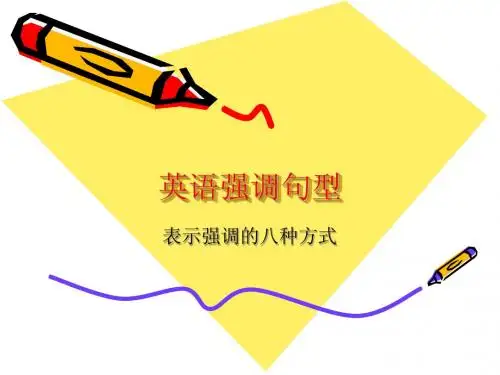
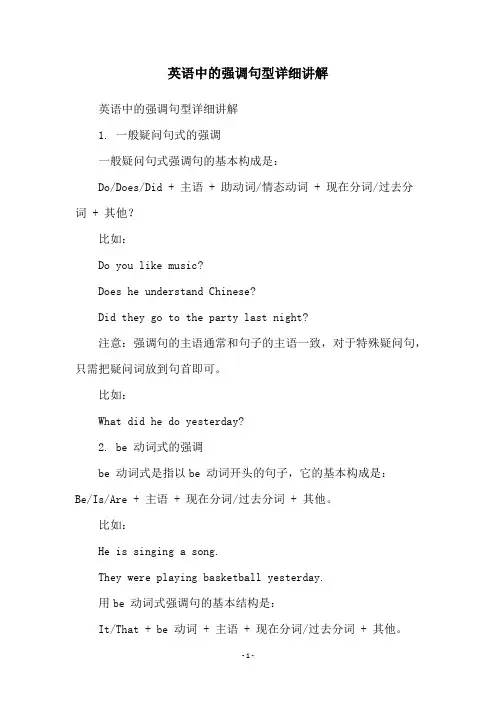
英语中的强调句型详细讲解英语中的强调句型详细讲解1. 一般疑问句式的强调一般疑问句式强调句的基本构成是:Do/Does/Did + 主语 + 助动词/情态动词 + 现在分词/过去分词 + 其他?比如:Do you like music?Does he understand Chinese?Did they go to the party last night?注意:强调句的主语通常和句子的主语一致,对于特殊疑问句,只需把疑问词放到句首即可。
比如:What did he do yesterday?2. be 动词式的强调be 动词式是指以be 动词开头的句子,它的基本构成是:Be/Is/Are + 主语 + 现在分词/过去分词 + 其他。
比如:He is singing a song.They were playing basketball yesterday.用be 动词式强调句的基本结构是:It/That + be 动词 + 主语 + 现在分词/过去分词 + 其他。
比如:It is he who is singing a song.That was they who were playing basketball yesterday.3. 助动词/情态动词式的强调助动词/情态动词式是指以助动词/情态动词开头的句子,它的基本构成是:助动词/情态动词 + 主语 + 动词原形 + 其他。
比如:He can play basketball.We must finish the work on time.用助动词/情态动词式强调句的基本结构是:It/That + 助动词/情态动词 + 主语 + 动词原形 + 其他。
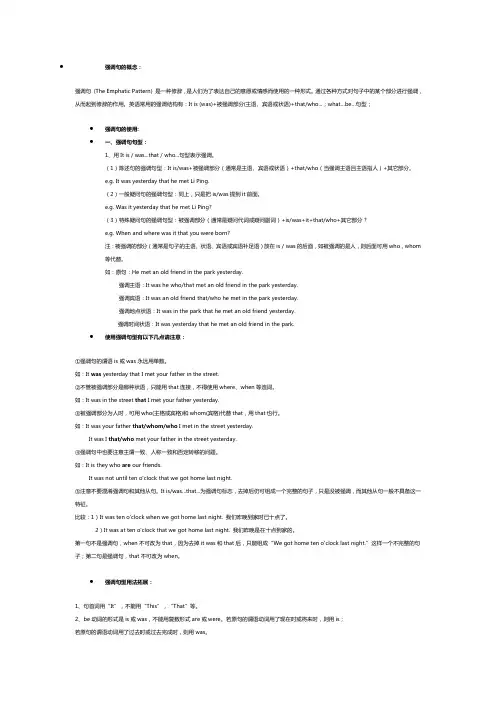
∙强调句的概念:强调句(The Emphatic Pattern) 是一种修辞,是人们为了表达自己的意愿或情感而使用的一种形式。
通过各种方式对句子中的某个部分进行强调,从而起到修辞的作用。
英语常用的强调结构有:It is (was)+被强调部分(主语、宾语或状语)+that/who...;what…be…句型;∙强调句的使用:∙一、强调句句型:1、用It is/was...that/who...句型表示强调。
(1)陈述句的强调句型:It is/was+被强调部分(通常是主语、宾语或状语)+that/who(当强调主语且主语指人)+其它部分。
e.g. It was yesterday that he met Li Ping.(2)一般疑问句的强调句型:同上,只是把is/was提到it前面。
e.g. Was it yesterday that he met Li Ping?(3)特殊疑问句的强调句型:被强调部分(通常是疑问代词或疑问副词)+is/was+it+that/who+其它部分?e.g. When and where was it that you were born?注:被强调的部分(通常是句子的主语、状语、宾语或宾语补足语)放在is/was的后面,如被强调的是人,则后面可用who,whom等代替。
如:原句:He met an old friend in the park yesterday.强调主语:It was he who/that met an old friend in the park yesterday.强调宾语:It was an old friend that/who he met in the park yesterday.强调地点状语:It was in the park that he met an old friend yesterday.强调时间状语:It was yesterday that he met an old friend in the park.∙使用强调句型有以下几点请注意:①强调句的谓语is或was永远用单数。

英语中表示强调的8种句式为了强调英语句子中的某一成份,强调方式是多种多样的,以下是整理的英语中表示强调的8种句式,供大家学习和参阅。
1.用形容词“very”,“single”等表示强调e.g.Red Army fought a battle on this very spot.红军就在此地打过一仗。
Not a single person has been in the office this afternoon.今天下午竟然没有一个人来过办公室。
2.用反身代词表示强调e.g.I myself will see her off at the station.我将亲自到车站为她送行。
You can do it well yourself.你自己能做好这件事情。
3.用助词“do”表示强调e.g.The baby is generally healthy,but every now and then she does catch a cold.那孩子的健康状况尚好,但就是偶尔患感冒。
Do be quiet.I told you I had a headache.务必安静,我告诉过你,我头疼。
4.用副词“very”,“only”,“even”,“too”等表示强调e.g.He drank it to the very last drop.他把它喝得一干二净。
Only in this way can we wipe out the enemy troops.只有用这样的方法我们才能消灭敌军。
He didn't answer even my letter.他甚至连我的信都未回。
I will too go!我要去的!5.用“...and that”,“...and those”,“not...too much”,“否定加否定”等结构表示强调e.g.They fulfilled the task,and that in a few days.他们在几天内完成的就是那项任务。
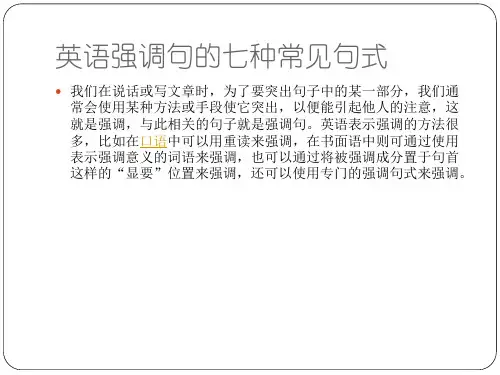
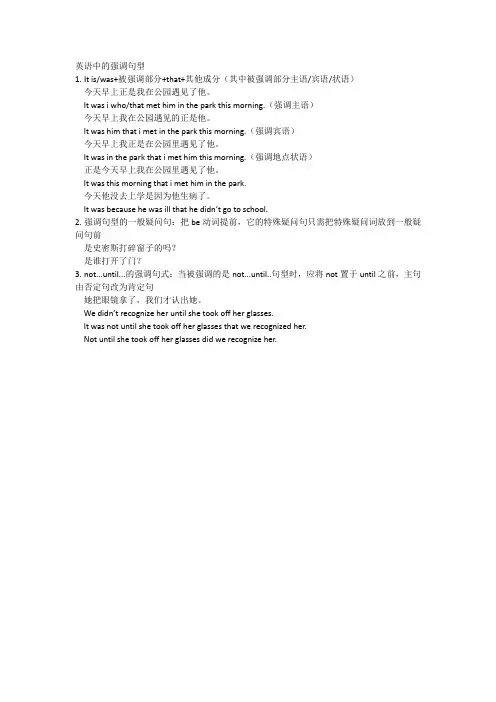
英语中的强调句型1.It is/was+被强调部分+that+其他成分(其中被强调部分主语/宾语/状语)今天早上正是我在公园遇见了他。
It was i who/that met him in the park this morning.(强调主语)今天早上我在公园遇见的正是他。
It was him that i met in the park this morning.(强调宾语)今天早上我正是在公园里遇见了他。
It was in the park that i met him this morning.(强调地点状语)正是今天早上我在公园里遇见了他。
It was this morning that i met him in the park.今天他没去上学是因为他生病了。
It was because he was ill that he didn’t go to school.2.强调句型的一般疑问句:把be动词提前,它的特殊疑问句只需把特殊疑问词放到一般疑问句前是史密斯打碎窗子的吗?是谁打开了门?3.not...until...的强调句式:当被强调的是not...until..句型时,应将not置于until之前,主句由否定句改为肯定句她把眼镜拿了,我们才认出她。
We didn’t recognize her until she took off her glasses.It was not until she took off her glasses that we recognized her.Not until she took off her glasses did we recognize her.。
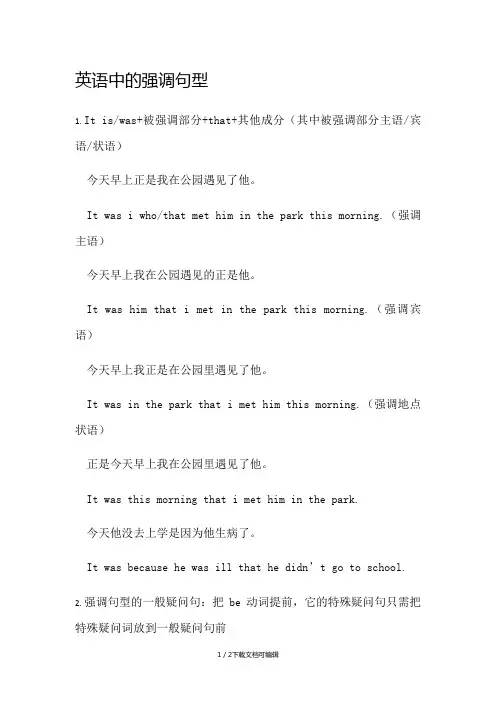
英语中的强调句型1.It is/was+被强调部分+that+其他成分(其中被强调部分主语/宾语/状语)今天早上正是我在公园遇见了他。
It was i who/that met him in the park this morning.(强调主语)今天早上我在公园遇见的正是他。
It was him that i met in the park this morning.(强调宾语)今天早上我正是在公园里遇见了他。
It was in the park that i met him this morning.(强调地点状语)正是今天早上我在公园里遇见了他。
It was this morning that i met him in the park.今天他没去上学是因为他生病了。
It was because he was ill that he didn’t go to school.2.强调句型的一般疑问句:把be动词提前,它的特殊疑问句只需把特殊疑问词放到一般疑问句前是史密斯打碎窗子的吗?是谁打开了门?3.not...until...的强调句式:当被强调的是not...until..句型时,应将not置于until之前,主句由否定句改为肯定句她把眼镜拿了,我们才认出她。
We didn’t recognize her until she took off her glasses.It was not until she took off her glasses that we recognized her.Not until she took off her glasses did we recognize her.(学习的目的是增长知识,提高能力,相信一分耕耘一分收获,努力就一定可以获得应有的回报)。

英语强调语句句式1、It is/was+被强调的部分(谓语除外)+that/which/who/whom引起的句子。
被强调的部分如果指人,作主语时,既可用that,也可用who,作宾语时,既可用that,也可用who/whom;被强调的部分如果指物,最好用that,也可用which;被强调的部分如果是时间状语、地点状语或方式状语,只能用that。
译成汉语时,被强调的部分常用“是”、“正是”、“就是”等词来表示强调的含义。
(1)Tom met our English teacher in the street last week.Tom上周在街上遇到了我们的英语老师。
It was Tom who/that met our English teacher in the street last week.被强调的部分是原句的主语,指人,故用that/who。
依据met可推出本句叙述的是过去发生的事情,故用was。
It was our English teacher who/whom/that Tom met in the street last week.被强调的部分是原句的宾语,指人,故用who/whom/that。
It was in the street that Tom met our English teacher last week.被强调的部分是地点状语,只能用that。
It was last week that Tom met our English teacher in the street.被强调的部分是时间状语,只能用that。
(2)Tom had a severe heart attack last week.Tom上周患了严重的心脏病。
It was a severe heart attack that/which Tom had last week.被强调的部分是原句的宾语,指物,最好用that,也可用which。
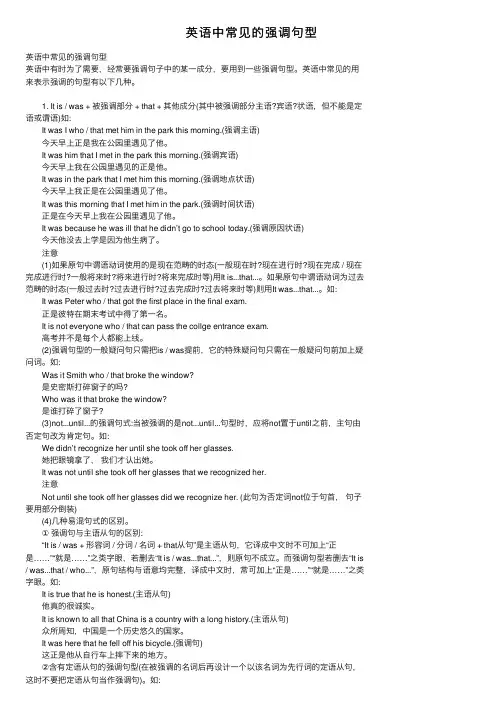
英语中常见的强调句型英语中常见的强调句型英语中有时为了需要,经常要强调句⼦中的某⼀成分,要⽤到⼀些强调句型。
英语中常见的⽤来表⽰强调的句型有以下⼏种。
1. It is / was + 被强调部分 + that + 其他成分(其中被强调部分主语?宾语?状语,但不能是定语或谓语)如: It was I who / that met him in the park this morning.(强调主语) 今天早上正是我在公园⾥遇见了他。
It was him that I met in the park this morning.(强调宾语) 今天早上我在公园⾥遇见的正是他。
It was in the park that I met him this morning.(强调地点状语) 今天早上我正是在公园⾥遇见了他。
It was this morning that I met him in the park.(强调时间状语) 正是在今天早上我在公园⾥遇见了他。
It was because he was ill that he didn’t go to school today.(强调原因状语) 今天他没去上学是因为他⽣病了。
注意 (1)如果原句中谓语动词使⽤的是现在范畴的时态(⼀般现在时?现在进⾏时?现在完成 / 现在完成进⾏时?⼀般将来时?将来进⾏时?将来完成时等)⽤It is...that...。
如果原句中谓语动词为过去范畴的时态(⼀般过去时?过去进⾏时?过去完成时?过去将来时等)则⽤It was...that...。
如: It was Peter who / that got the first place in the final exam. 正是彼特在期末考试中得了第⼀名。
It is not everyone who / that can pass the collge entrance exam. ⾼考并不是每个⼈都能上线。

英语中的强调句型王珂1. It is + 被强调部分+ that ...该句型是强调句型。
将被强调的部分放在前面,其它部分置于that之后。
被强调部分可以是主语,宾语,表语或状语。
强调的主语如果是人,that可以由who换用。
如果把这种句型结构划掉后,应该是一个完整无缺的句子。
这也是判断强调句型与其它从句的方法。
It was about 600 years ago that the first clock with a face and an hour hand was made.It was they that (who ) cleaned the classroom yesterday.It was in the street that I met her father.2. It is not until + 被强调部分+ that ...该句型也是强调句型。
主要用于强凋时间状语,译成汉语"直到...才...",可以说是not ... until ... 的强调形式。
It was not until she took off her dark glasses that I realized she was a famous film star.= Not until she took off her dark glasses did I realize she was a famous film star.= I didn’t realize she was a famous film star until she took off her dark glasses.3. It is clear ( obvious, true, possible, certain....) that .....该句型中it 是形式主语,真正的主语是that 引导的主语从句,常译为"清楚(显然,真的,肯定...)"是主语从句最常见的一种结构。
强调句1.It is……that……对句子状语的强调(1)It was in an internet bar that the parents found their son who had been away from home for a week.正是在一家网吧里,父母找到了离家出走已经一个星期的儿子。
(2)It was because the water had risen that they could not across the river.正是由于水涨了,他们没法过河。
(3)It was not until I met you that I knew real happiness.直到我遇到你以后,我才真正体会到幸福。
2.It is……that……对句子主语、宾语或补足语的强调:(1)It is you that are to blame.该受责备的人就是你。
(2)It is the protection for the trees that really matters, rather than how many trees are planted.真正重要的在于对树木的保护,而不在于种了多少树。
(3)It is what you do rather than what you say that matters.重要的是看你怎么做,而不是看你怎么说。
(4)It was how the young man had learned five foreign languages that attracted the audience’s interest.引起观众们的兴趣的是这位年轻人怎样就学会了5门外语。
3.It is……that……句式的一般疑问句:(1)Was it while watching the football game that they kept shouting at the top of their voices?是在看足球比赛那会儿,他们扯大嗓门不停叫喊的吗?(2)Was it only when she reread his poems recently that she began to appreciate their beauty?她是否是在再次读到他的诗歌时才开始欣赏到它们的美?4.It is……that……出现在特殊疑问句中:(1)Where was it that you saw the man?你是在哪儿看到了那个人的?(2)How is it that your answer differs from his?你的答案跟他的答案怎么个不同?(3)Why is it that you want to change your idea?是什么原因使你想要改变想法?5.习语中的“It is+名词词组+that……”句式:(1)It is a wise man that never makes mistakes.再聪明的人也会犯错误。
英语的强调句型有以下这些:
1. It is/was + 被强调部分+ that/who + 句子其余部分。
例如:It was John who won the singing competition.
翻译:是约翰赢得了唱歌比赛。
2. What/How + 被强调部分+ 句子其余部分。
例如:What a beautiful sunset it is!
翻译:多美的日落啊!
3. Not only + 助动词/情态动词+ 主语+ 谓语,but also + 强调部分。
例如:Not only did she pass the exam, but she also got the highest score. 翻译:她不仅通过了考试,而且还获得了最高分。
4. 虚拟形式的强调句型:
If only + 主语+ 过去式,(then) + 结果。
例如:If only I had studied harder, I would have passed the test.
翻译:要是我当时学得更努力就好了,我就能通过那次考试了。
这些强调句型可以帮助我们在表达中有效地突出某个信息。
请注意,具体使用哪种强调句型取决于语境和强调的对象。
高中英语教科书中强调句出现的特别多,强调句只是强调句子的某一成分(通常是主语、宾语、或状语),人们用强调句来表达自己的意愿或情感,这个语法知识既是重点又是难点,学生不容易理解和运用强调句,下面我对这个知识点归纳一下:1 强调陈述句:“ It is/was+被强调部分+that/who+原句其他部分”来强调说话人的愿意。
如:原句:I met Mr. Zhang in the school library yesterday.强调主语:It was I that/who met Mr. Zhang in the school library yesterday.强调宾语:It was Mr. Zhang that/whom I met in the school library yesterday.强调地点状语:It was in the school library that I met Mr. Zhang yesterday.强调时间状语:It was yesterday that I met Mr. Zhang in the school library.注意:(1)在强调主语时,that 后的谓语动词要与被强调者保持人称和数的一致。
如:It is I who am a student.(2)强调状语时,连接词只能用that,无论被强调部分是表示地点还是表示时间意义的名词,都不可以用where或者when。
强调人时,可以用who/that(在从句中作主语)或whom/that(在从句中作宾语)。
(3)原句的谓语动词时态是一般过去时,过去进行时和过去完成时,用It was…,其他时态用It is…。
(4)对“…not … until…”这个句型进行强调时,一般使用“ It is/was …not …until…that…”这一句型进行强调。
如:原句:My mother didn''t come home until 12 o''clock last night.强调句:It was not until 12 o''clock last night that my mother came home.原句:I didn’t realize she was a famous singer until she took off her dark glasses.强调句:It was not until she took off her dark glasses that I realized she was a famous singer.2强调句的一般疑问句型:”Is/Was+it+被强调部分+that/who/whom+原句其他部分?”如:原句:Did you meet Mr. Zhang in the school library yesterday ?强调主语:Was it you that/who/ met Mr. Zhang in the school library yesterday ?强调宾语:Was it Mr. Zhang that/whom you met in the school library yesterday ?强调地点状语:Was it in the school library that you met Mr. Zhang yesterday?强调时间状语:Was it yesterday that you met Mr. Zhang in the school library?3强调句的特殊疑问句型:特殊疑问词+is/was+it + that…如:原句:When did he make up his mind to leave his county ?强调句:When was it that he made up his mind to leave his county ?4强调句的特殊疑问句型如果用在宾语从句时,要把Be动词和it的顺序换成陈述句的顺序。
英语强调句型详说我们在说话、写文章的过程中,为了要突出句子中的某一部分时,就常使用某种方法、手段使它突出,以便能引起他人的注意,这就是强调。
英语中,表示强调的方法一般分为三种:位置的强调;用词强调;句型强调。
如:一、位置强调英语句子的语序,一般为:主、谓、宾、表、状。
有时为了强调某个成份,就故意将它移到句首或句末。
如:A. 强调主语及状语。
如:(1) I was reading English this morning. —This morning, I was reading English. 今天早晨,我一直在读英语。
(2) I’ll go to see Li Lei tomorrow. — Tomorrow, I’ll go to see Li Lei. 明天,我要去看李蕾。
B. 强调谓语(as, though引导的让步状语从句)(1) Though he will try, he can’t succeed. — Try as / though he will, he can’t succeed. 尽管他会尝试,但他不会成功。
(2) Though she can sing, she can’t sing well. — Sing though / as she can, she can’t sing well. 尽管她会唱,但唱得不好。
C. 强调宾语或表语(as, though引导的让步状语从句)1) Though he learnt English, he didn’t learn it well. —English as / though he learnt, he didn’t learn it well. 尽管他学过英语,但他学得并不好。
(2) Though he is ill, he keeps on working. —Ill as / though he is, he keeps on working. 尽管他有病,他仍坚持工作。